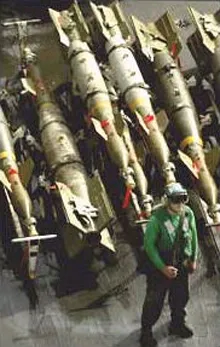
Bunker Buster Bob
The GBU-28 is a 4000 pound bomb that is designed to penetrate hardened targets before exploding. The Guided Bomb Unit-28 (GBU-28) is a special weapon developed for penetrating hardened Iraqi command centers located deep underground. This 5000 lb bunker buster was required for special targets during the Desert Storm conflict and was designed, fabricated and loaded in record time.
The GBU-28 is a 5,000-pound laser-guided conventional munition that uses a 4,400-pound penetrating warhead. The bombs are modified Army artillery tubes, weigh 4,637 pounds, and contain 630 pounds of high explosives. They are fitted with GBU-27 LGB kits, 14.5 inches in diameter and almost 19 feet long. The operator illuminates a target with a laser designator and then the munition guides to a spot of laser energy reflected from the target.
The GBU 28 "Bunker Buster" was put together in record time to support targeting of the Iraqi hardened command bunker by adapting existing materiel. The GBU-28 was not even in the early stages of research when Kuwait was invaded. The USAF asked industry for ideas in the week after combat operations started. The bomb was fabricated starting on 1 February, using surplus 8-inch artillery tubes. The official go-ahead for the project was issued on 14 February, and explosives for the initial units were hand-loaded by laboratory personnel into a bomb that was partially buried upright in the ground outside the laboratory in New York.
The first two units were delivered to the USAF on 16 and 17 February, and the first flight to test the guidance software and fin configuration was conducted on 20 February. These tests were successful and the program proceeded, with a contract let on 22 February. A sled test on 26 February proved that the bomb could penetrate over 20 feet of concrete, while an earlier flight test had demonstrated the bomb's ability to penetrate more than 100 feet of earth.
The Energetic Materials Branch of Air Force Research Laboratory (AFRL/MNME) is the home of the High Explosives Research and Development (HERD) Facility. This facility was established to provide the Air Force with a modern in-house explosive research, development, test and evaluation (RDT&E) capability and quick reaction explosives loading. The HERD Facility includes the Explosives Properties Laboratory, the Explosives Processing Laboratory, and the Explosives Dynamics Laboratory,as well as other explosives storage and test buildings. The HERD responded to an immediate need for explosive loading of the GBU-28 warhead (BLU-113). The first two warheads were received at the HERD, loaded, x-rayed and delivered to the Desert Storm theater of operations within 72 hours. The first two operational bombs were delivered to the theater on 27 February.
The Air Force produced a limited quantity of the GBU-28 during Operation Desert Storm to attack multi-layered, hardened underground targets. Only two of these weapons were dropped in Desert Storm, both by F-111Fs. One weapon hit its precise aimpoint, and the onboard aircraft video recorder displayed an outpouring of smoke from an entrance way approximately 6 seconds after impact. Initially it was reported that one of the GBU-28s was used to destroy a bunker in a residential neighborhood of Bagdad, that turned out to be a shelter for hundreds of key family members of the Ba'ath Party elite. Originally over 500 casualties were reported, but that was later changed to 314. After the war it was reported that an F-117 dropped a Penetrator I-2000 on this target, and that it was not one of the GBU-28's from an F-111.
Your musical influences
Looks like the USA has more weapons of mass destruction than everybody in the world put together!